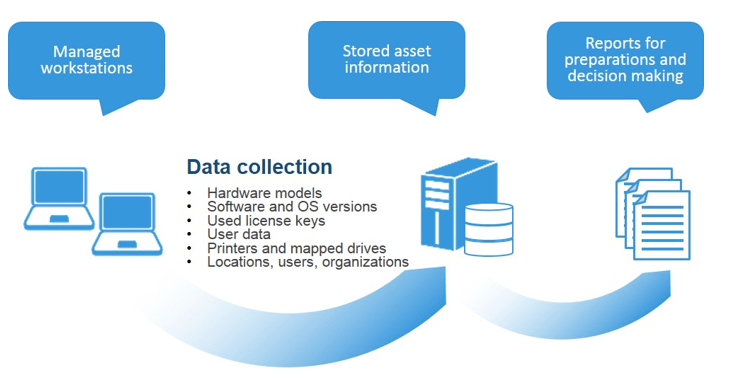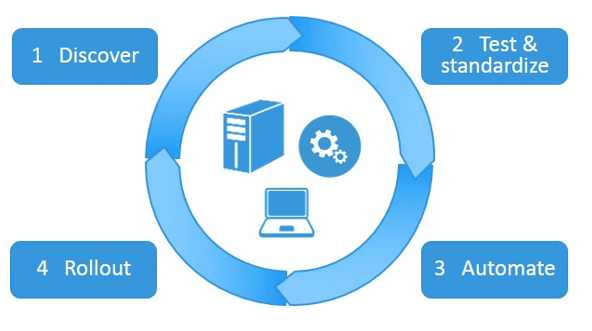Operating System Migration
White Paper Operating System Migration
Executive summary
With the continual evolution of operating systems, corporate software, and hardware technologies, IT managers are required to upgrade their organization to newer operating systems every three to five years.
The process of migrating workstations to the next version of an operating system or upgrading a user’s hardware after a lease expires can be an expensive and time-consuming project.
Organizations typically face numerous challenges during operating system upgrades. Without careful planning and preparation, this is likely to lead to high costs, lost time, and lower quality to both end-users and IT staff. In most cases, hardware or operating system migration projects are planned case by case and are always customer-specific, although the process, challenges, and requirements are always the same. In the worst case scenario, a local IT service provider performs the operating system upgrades manually and handles any challenges only as they appear; for example, spending several hours backing up and restoring user data, installing user-specific software, and searching for what software and license keys are associated with each user.
This white paper introduces the main challenges of an operating system migration project and how Miradore Management Suite’s built-in workflows help to overcome these challenges. With Miradore Management Suite, most of the migration tasks can be automated and performed remotely. For IT service providers, Miradore Management Suite provides a cost-effective and optimized solution for upgrading customers’ workstation environments regardless of their size, network performance, and geographic locations.
Challenges in operating system migrations
Once an organization makes the decision to upgrade their workstations to a new operating system, IT service providers are faced with extensive pre-deployment auditing and planning in order to implement a successful rollout with minimal disruption to the organization’s day-to-day operations. In addition, the IT service provider’s goal is to limit the number of helpdesk calls due to missing drivers, user data, applications, or configuration settings.
1. Hardware compliance audit
IT service providers typically start the project by auditing the organization’s existing environment to determine what type of hardware is used by their customer base. This allows IT service providers to determine how many different hardware models are supported and whether they meet the requirements of the new operating system. In some cases, the existing hardware is insufficient and will need to be replaced outright. In other cases, the existing hardware only requires minor upgrades to system memory or disk space. In cases where the current hardware models are supported by the new operating system, IT service providers will need to verify that the new hardware drivers for each model are supported.

2. Software compliance audit
A review of the corporate software standard is performed to determine the state of the existing standard and determine if any software can be added or removed. In addition, IT service providers use the software audit to ensure all software is still supported by the new operating system; if software is not supported, new versions or replacements for the software need to be identified.
In addition to corporate standards, each business unit and location within the organization has individual standards based on their business function. For example, all the employees within the sales organization might require CRM software, but the engineering department requires CAD software. In addition to business unit requirements, each location and country can have specific software that must be identified and supported including operating system settings like time zones, language preferences, keyboard settings, etc. for each country.
Once the organization, business unit, and location specific software standards have been identified, the IT service providers need to perform an audit on the individual user’s software requirements to identify and ensure individual software requirements are not missed during the re-installation of the workstation. Special attention needs to be paid in order to ensure that users’ software licenses are recorded and copied when re-installing individual software.
This single requirement can be one of the biggest challenges for an operating system refresh project and typically results in the majority of post replacement tickets and user complaints.
Upon completion of the software audit, IT service providers must test and certify all existing software products in order to verify that they are supported by the new operating system. This process will produce a list of all supported and unsupported software and identify any risks to the project. In addition, it provides the IT service providers with a list of software that is supported by the new operating system.
3. Software license compliance audit
Upon completion of the corporate standard and user specific software audits, a software license compliance audit is performed in order to determine if the organization is compliant with the actual licenses purchased by the organization. If the audit determines that additional software is installed within the organization, then the organization can decide whether new licenses should be purchased or existing software removed. When software is removed from existing users during the migration process, the end users typically experience frustration and lost time while they submit new requests to get the software approved and installed.
In many cases during the audit process, questions are raised to determine if the software is actually being used or even required by a user. When and why was the software installed? Was the installation approved by someone and does the user or organization have a license key for the software?
In addition, all the license keys for software installed within the organization needs to be recorded and stored.
4. User data and configurations audit
Care needs to be taken in determining where users are storing their personal data on the device and steps taken to ensure this data is backed up and restored back to the device when the operating system has been upgraded.
In order to reduce the amount of post upgrade support tickets, the user’s printer, network drive, and other user-specific configuration settings must be recorded as well.
Remote migration with Miradore
Miradore Management Suite addresses all of the aforementioned challenges by providing an extensive set of easy-to-use tools for each phase of the migration process in a single integrated solution.

1. Discover
With the help of Miradore Management Suite, IT service providers always have accurate inventory data on managed devices, automatically updated at regular intervals, for planning the operating system migration. In addition, IT service providers can manually launch inventory scans to selected devices across a single location, organization, or the entire Managed Services Customer base, whenever they feel necessary.
With Miradore Management Suite’s real-time auditing system, IT service providers can run reports to find out which devices do not meet the requirements of the new operating system and quickly identify missing device drivers required for the new operating system.
Since Miradore Management Suite automatically tracks the software installed at the organization, location and user level, IT service providers can quickly run reports to identify what software is installed, which users are using it and whether the installed software is missing any software licenses. This eliminates the need to perform manual license compliance audits and reduces the amount of manual information gathering by IT service providers.
2. Test & standardize
After the discovery phase is complete, the IT service providers can start testing the identified hardware and software compatibility with the new operating system.
Hardware compatibility
With the help of Miradore Management Suite’s advanced driver management, administrators simply run a driver report to verify that Miradore contains all the supported drivers for the required hardware platforms. If any hardware models are missing drivers, they can be easily added and the report can be re-run to make sure that all the models are supported prior to the rollout.
Software compatibility and auditing
Once IT service providers have verified that all the required hardware is supported by the new operating system, they can begin to test and certify all the organization, location, and user software identified in the discovery phase. Once the compatibility of each software package has been verified on the new operating system, IT service providers can update the software profile to support the new operating system.
Because Miradore Management Suite tracks all the software installed on a workstation and its frequency of use in real-time, IT service providers can use this information to run reports and identify any unassigned software, unused software, or unassigned software licenses throughout the organization. This allows management to identify and address software compliance issues with users prior to the operating system migration.
3. Automate
With Miradore Management Suite’s dynamic operating system deployment process, organizations no longer have to struggle with the challenges involved in image management, standardized hardware, and device driver management, eliminating a majority of the challenges organizations face today in heterogeneous IT environments.
With Miradore Management Suite’s hierarchical structure for modelling software based on organization, business unit, location, and individual user, the installation of software during an operating system migration happens seamlessly. Once the operating system has been installed, the Miradore client starts installing software located in each unit until all the corporate and user specific software has been installed.
With the help of Miradore Management Suite’s Endpoint Backup feature, user data is automatically backed up to a local or remote storage device. The device’s backup status is automatically updated in Miradore Management Suite to ensure that the technician knows there is an up-to-date backup before the upgrade. Once the upgrade is complete, the technician can start the restoration process remotely without ever leaving his/her desk.
4. Rollout
Miradore Management Suite simplifies the rollout process by allowing IT service providers to perform remote group installations from a central location based on organization, location, or groups of individual workstations. Once the group installation has commenced, IT service providers can run a report to view how many of the installations were successful, how many installations failed, and why the installation may have failed.
In addition, Miradore Management Suite supports pilot group installations in order to minimize the risk of errors during a rollout. Once the pilot installations are complete and verified as supported by the new operating system, the template can be approved for across the entire organization.
Miradore Management Suite’s Remote Control feature can be utilized by the support function for providing timely user guidance after the installations, therefore eliminating the need for unnecessary and inefficient travelling to remote offices. In addition, Remote Control can be used even when the user is outside the company network, so mobile employees can be reached just as efficiently.
Conclusion
Using proven best-in-class business processes and automation technology, Miradore Management Suite addresses the challenges that IT service providers face when migrating managed devices to new operating systems. Miradore Management Suite can dramatically cut the cost of performing IT audits, software testing, and operating system deployment.
Let us show you how Miradore Management Suite simplifies the auditing, testing, and deployment of new operating systems and software while reducing the amount of time, labor, and expenses involved in migrating your customers to the latest operating system. Contact Miradore today to see how we can optimize your costs savings and streamline your business processes.
